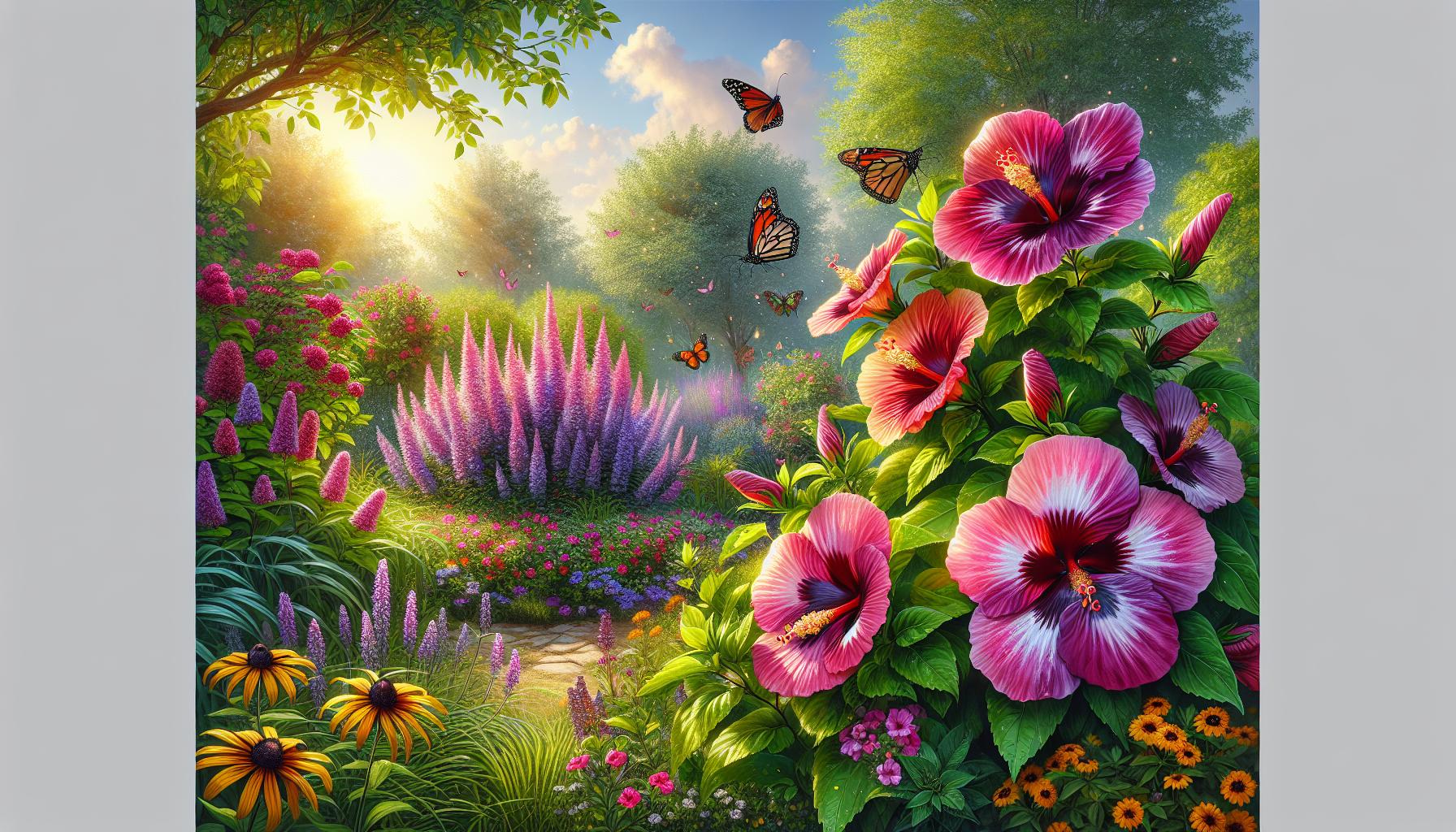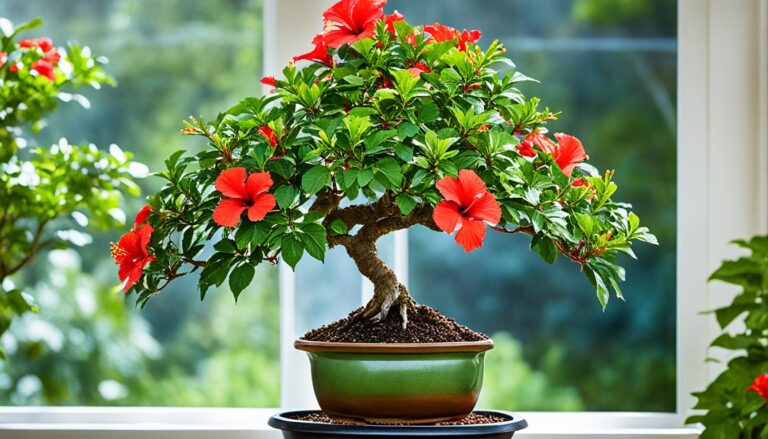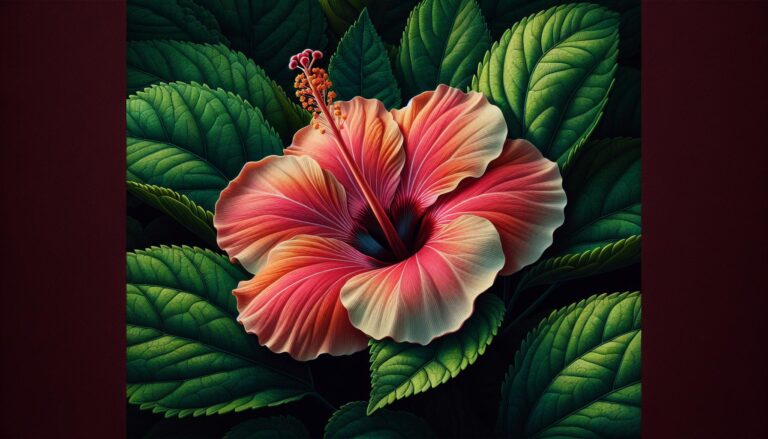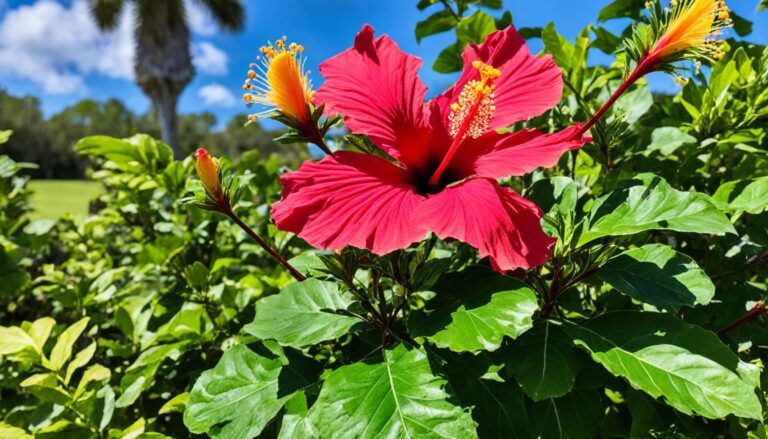Luna Hibiscus Care Guide: Grow Vibrant Blooms & Attract Butterflies
Imagine a garden where the blooms are so large they nearly hide the foliage beneath them, painting a vivid tapestry of red, rose, white, and lilac-pink against a lush green backdrop. That’s the magic the Luna Mix Hibiscus brings to landscapes. Known as the first rose mallow to bloom from seed within the first year, this variety has revolutionized expectations with its dinner plate-sized flowers and robust growth. It’s not just a feast for the eyes; it’s a magnet for hummingbirds while being deer-resistant, making it an ideal choice for gardeners seeking both beauty and functionality.
The Luna hibiscus stands out in the vast family of hibiscus plants, which includes varieties as diverse as okra and tropical hibiscus. What sets it apart is its ability to thrive from seed, offering an accessible option for growers and a burst of color from late spring through mid-September. Thriving in full sun and adaptable to a range of soil conditions, including wet areas, Luna hibiscus exemplifies resilience and versatility. As we delve deeper, we’ll explore the unique characteristics that make Luna hibiscus a standout choice for gardeners and landscape designers alike.
Key Takeaways
Overview of Luna Hibiscus
Botanical Description
Luna Hibiscus, scientifically known as Hibiscus moscheutos, stands out in the garden with its hardy, bushy growth and remarkable flowering capabilities. This perennial plant reaches heights of 24 to 36 inches and spreads approximately 24 inches wide, presenting an upright, well-branched habit that’s both attractive and robust. Luna hibiscus flourishes in full sun, thriving in average to wet soil conditions. It’s particularly noted for its ability to perform well even in moist, organically rich soils, a testament to its adaptability and resilience. The plant’s preference for regular, deep watering, and its heat and humidity tolerance makes it a valuable addition to a range of garden settings. Air circulation plays a crucial role in maintaining the plant’s health, encouraging the production of its large, showy flowers while minimizing the risk of diseases. As it emerges slowly from dormancy in spring, the Luna hibiscus rapidly catches up, producing lush foliage and vibrant blooms through the summer until the late season.
Varieties and Colors
Luna hibiscus blooms stand as a focal point in any garden, presenting a palette of colors that create stunning visual interest. The Luna series offers a range of varieties, including ‘Luna Red’, ‘Luna Pink Swirl’, ‘Luna White’, and ‘Luna Rose’, each variety bringing its unique charm to the landscape. The flowers span 6 to 8 inches in diameter, showcasing hues from deep burgundy and soft pink to pure white and rose, often with a contrasting eye that intensifies their allure. These varieties ensure a spectacular display that not only attracts the eyes of admirers but also serves as a haven for pollinators like butterflies, adding life and vibrancy to the garden. Beyond their beauty, these varieties share the Luna hibiscus’s commendable attributes of low maintenance, adaptability to various watering regimes, and a bushy, well-branched growth habit that makes them ideal for both container gardening and perennial borders.
Growth and Care Guide

Ideal Growth Conditions
Luna Hibiscus flourishes in environments that offer full sunlight exposure and access to moist, organically rich soils. Despite its preference for wet conditions, this plant demonstrates a surprising adaptability to average garden soils, as long as they don’t dry out. For the Luna Hibiscus to thrive, maintaining consistent moisture levels in the soil is key, alongside ensuring the plant receives ample sunlight. While it tolerates some light shade, full sun paired with good air circulation promotes the most vigorous growth, producing the largest and most colorful blooms. Adding to its robust nature, the Luna Hibiscus is heat and humidity tolerant, making it a versatile choice for gardeners in various climates.
Planting Tips
When planting Luna Hibiscus, selecting a site protected from strong winds will minimize the risk of windburn, contributing to the plant’s overall health and aesthetics. The optimal planting period is in spring, giving the plant ample time to establish its root system before the peak of summer. Incorporating a generous amount of organic matter into the planting hole enriches the soil, enhancing the growth conditions for the Luna Hibiscus. For gardens with poor soil drainage, raising the planting area into a mound helps prevent waterlogging, promoting healthier root development. Despite its hardy nature, providing a winter mulch in colder zones can protect the root system from freezing temperatures, ensuring a robust comeback in spring.
Watering and Fertilization Needs
Regular, deep watering is essential for Luna Hibiscus, especially during the warmest months of the year. This practice not only helps maintain the soil’s moisture levels but also encourages deeper root growth, which is vital for the plant’s resilience to dry conditions. While the Luna Hibiscus can cope with occasional dry spells, prolonged dryness leads to leaf scorch, underscoring the importance of consistent watering. Fertilization plays a crucial role in the plant’s growth and blooming capability. A balanced, slow-release fertilizer applied in early spring provides the necessary nutrients for the initial growth spurt. Additional feeding with a water-soluble fertilizer every 4-6 weeks during the growing season supports sustained blooms and vigorous foliage. However, it’s essential to avoid over-fertilization, which can lead to excessive foliage at the expense of blooms and potentially harm the plant.
Common Uses in Landscaping

Landscaping with Luna Hibiscus offers endless possibilities, elevating outdoor spaces with its stunning blooms and versatile planting options. We’ll guide you through the best uses in landscaping, focusing on companion plants and design ideas that enhance the beauty and diversity of your garden.
Companion Plants
Companion planting plays an essential role in creating a harmonious and healthy garden environment. The Luna Mix Hibiscus, with its eye-catching flowers, pairs well with several plants for added visual interest and ecological benefits.
- Butterfly Bush (Buddleia): This plant serves as an excellent partner for Luna Hibiscus, attracting butterflies and other pollinators while offering contrasting foliage and flower form.
- Blackeyed Susan (Rudbeckia fulgida ‘Goldsturm’): Its bright yellow flowers provide a stunning color contrast against the bold hues of the Luna Hibiscus, creating a lively and vibrant garden display.
- Sneezeweed (Helenium ‘Mariachi™ Fuego’): The fiery colors of Sneezeweed complement the deep tones of Luna Hibiscus, enhancing the garden’s warm palette and extending the blooming season.
These companions ensure a flourishing garden by attracting beneficial insects, creating diverse habitats, and offering varying textures and colors for visual depth.
Design Ideas for Gardens
Luna Hibiscus lends itself to a variety of garden designs, from formal to the more naturalistic. Here are some design ideas where Luna Hibiscus can shine:
- Accents or Group Plantings: Planting Luna Hibiscus in groups or as solitary accents brings focus to its spectacular blooms, especially in large garden spaces.
- Border Plantings: Utilize the statuesque form and vibrant color of Luna Hibiscus to create stunning, dense borders along garden edges or walkways.
- Woodland Gardens: Integrate Luna Hibiscus into woodland garden designs, where its flowers add light to shaded areas and contrast beautifully against green foliage.
- Naturalized Areas: Including Luna Hibiscus in naturalized garden areas or near ponds and streams creates a visually appealing transition from cultivated spaces to more wild settings.
- Rock Gardens: Despite its larger size, Luna Hibiscus can be incorporated into rock garden designs, where its dramatic blooms complement rugged textures and forms.
In each of these designs, Luna Hibiscus stands out, bringing life and color to the garden. Its adaptability to various soil conditions and landscape uses makes it a versatile choice for gardeners looking to enhance their outdoor spaces with ease and style.
Propagation Techniques

Expanding your garden with Luna Hibiscus, or Hibiscus moscheutos, involves understanding effective propagation techniques. This section delves into two primary methods: seed germination and propagation through cuttings and division. Each technique offers a pathway to cultivating these vibrant plants, contributing to the diverse and ecologically rich landscape in your garden.
Seed Germination
Germination plays a crucial role in propagating Luna Hibiscus from seeds. Seeds often show higher germination rates when exposed to consistent moisture and the right temperature conditions. For best results, sow Luna Hibiscus seeds indoors about 12 weeks before the last expected frost. Use a sterile seed starting mix and place the seeds at a shallow depth, barely covering them with soil. Maintain the soil’s moisture without making it soggy, and provide a steady temperature of around 75°F (24°C) to encourage germination. Seeds typically sprout within 14 to 21 days. Once seedlings develop their second set of true leaves and there’s no risk of frost, they’re ready to be transplanted outdoors. Choose a sunny location with well-draining, rich soil to ensure the best growth.
Cuttings and Division
Aside from seeds, propagating Luna Hibiscus through cuttings and division is an effective way to expand your collection. For cuttings, select healthy, non-flowering stems during the growing season. Cuttings should be about 4 to 6 inches long, with leaves removed from the lower half. Dip the cut end in rooting hormone and insert into a pot filled with moist, well-draining potting mix. Cover the pot with a plastic bag to retain humidity and place it in indirect sunlight. Roots usually develop within 4 to 6 weeks.
Division, on the other hand, is ideal for mature Luna Hibiscus plants. In early spring or late fall, carefully dig up the plant, ensuring you don’t damage the roots. Use a clean, sharp tool to divide the root ball into sections, each with several shoots and a healthy root system. Replant each division promptly, maintaining the original planting depth, and water thoroughly. Divisions help manage plant size, promote vigorous growth, and produce blooms true to the parent plant.
Both seed germination and propagation via cuttings and division allow gardeners to multiply their Luna Hibiscus plants effectively. Providing the right care post-propagation ensures these plants continue to thrive, adding beauty and attracting pollinators to your garden.
Pests and Diseases

Identifying Common Issues
Our discussion on Luna Hibiscus maintenance wouldn’t be complete without addressing the potential pests and diseases these plants may encounter. Despite their hardy nature, Luna Hibiscus can fall prey to specific issues if not monitored closely. Recognizing the signs early plays a crucial role in maintaining the health and beauty of these perennials.
Common diseases affecting Luna Hibiscus include rust, which appears as orange or yellow spots on the undersides of leaves, and leaf spot, characterized by brown or black spots that can lead to premature leaf drop. Canker, another disease to look out for, causes sunken, discolored areas on stems or branches, potentially leading to weakened plants.
As for pests, Japanese beetles pose a significant threat, with their appetite for Luna Hibiscus leaves resulting in severe damage if unchecked. Occasional insect problems may also arise from aphids and spider mites, which tend to suck sap from the leaves, causing them to yellow and drop.
Identifying issues requires a keen eye. Look for unusual spotting on leaves, wilted or discolored foliage, and any signs of insect activity. Regular inspections ensure early detection, allowing us to take swift action to mitigate any problems.
Prevention and Treatment
Preventing these pests and diseases starts with good cultural practices. Ensuring Luna Hibiscus are planted in well-draining soil with plenty of air circulation significantly reduces the risk of disease. We also recommend watering plants at their base in the morning to minimize moisture on leaves, which can lead to fungal diseases.
When it comes to treatment, our approach involves both organic and chemical solutions, depending on the severity of the issue. For fungal diseases like rust and leaf spot, applying a fungicide early in the season, as a preventive measure, can be beneficial. Insects such as Japanese beetles and aphids can often be managed through physical removal or the use of insecticidal soaps and neem oil, which are less harmful to beneficial pollinators visiting the Hibiscus.
In severe cases, chemical pesticides may be necessary, but we always advise using these as a last resort. Integrated Pest Management (IPM) practices, combining biological, cultural, and chemical tools, offer a more sustainable approach to managing pests and diseases.
Our commitment to maintaining healthy Luna Hibiscus plants involves diligent care and attention to detail, ensuring they continue to thrive and bring joy to our gardens. By taking proactive steps in identifying potential issues and implementing effective prevention and treatment strategies, we enhance the resilience of these beautiful plants against common pests and diseases.
Conclusion
We’ve explored the vibrant world of Luna Mix Hibiscus, highlighting its stunning blooms and the joy it brings to gardens. With its preference for full sun, moist soils, and the company of pollinators, it’s clear this plant is a must-have for enthusiasts seeking to add a splash of color and life to their outdoor spaces. By following our planting tips and maintenance advice, you’ll ensure your Luna Hibiscus thrives, offering a picturesque view and a haven for wildlife. Remember, successful gardening with this perennial means paying attention to its needs and responding with care. Whether you’re accentuating your garden’s borders or creating a focal point in a naturalized area, Luna Hibiscus stands out as a versatile and captivating choice. Let’s embrace the beauty and resilience of this plant, making our gardens not just a sight to behold but a testament to our dedication to nurturing nature’s wonders.






